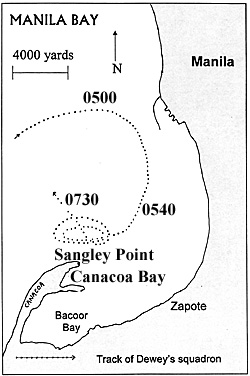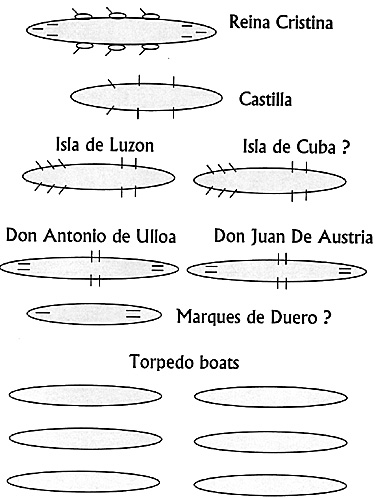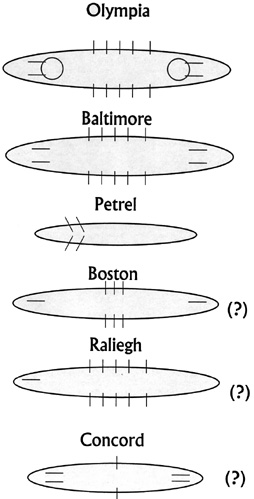 The Battle of Manila Bay is known to us now as an easy victory for the Americans. Roughly a century ago, May 1, 1989, Commodore Dewey destroyed the Spanish fleet under Admiral Montojo y Pasaron. There were no American casualties from Spanish fire. So it's easy to conclude this was no contest, but the qualified observers before the battle had a different view.
The Battle of Manila Bay is known to us now as an easy victory for the Americans. Roughly a century ago, May 1, 1989, Commodore Dewey destroyed the Spanish fleet under Admiral Montojo y Pasaron. There were no American casualties from Spanish fire. So it's easy to conclude this was no contest, but the qualified observers before the battle had a different view.
When Dewey sailed out of Hong Kong toward Manila, a British naval officer observed, "They are splendid chaps but we shall never see them again." There were a number of ways the Spanish could have made the battle much tougher. A soloist could select one or more of these and play out the battle. Be the first player to lose the Battle of Manila Bay! Actually you would be the second. I once set up a battle covering the floor of a room with Manila Bay twenty five feet across. The fleets were commanded by teenage boys, and the Spanish fleet won.
Later on I will list the ships and their specifications for you. I have provided a simple set of rules and a map of Manila Bay. You can roll a single six-sided die to select the Spanish strategies.
Assume you are Commodore Dewey in charge of the following fleet: Olympic (flag), Raleigh, Petrel, Concord, Boston, and McCullock. Write your battle orders. You may assume the Spanish fleet will consist of at least the following: Riena Cristina (flag), Castilla, Don Juan de Austria, Don Antonia de Ulloa, Isle de Luzon, Isle de Cuba, and Marquis del Duero. There may be shore batteries, and mines are a possibility. The battle will start between 5:00 and 6:00 a.m.
Programmed Orders
- Do not read these until you have written orders!
1. All Spanish ships on the list above will deploy in a line in Bacoor Bay well inside the bay with guns pointed toward the mouth of the bay. They will arrange themselves left to right as listed above. At Sangley Point there will be two 5.9 and two 4.7 breech loading rifles. At Zapote there will be four 9.4 inch breech loading rifles. These will be positioned to cover the mouth of the bay with a crossfire.
2. Same basic deployment of ships as above but not the shore guns. Add the following: six torpedo boats positioned in three locations: two behind the breakwater in front of Manila, two at Zapote, and two at Canacoa Bay. At the signal of a green rocket the six torpedo boats will all advance on the Americans and fire torpedoes from three angles. At the same time, ships in the regular fleet will advance.
3. Combine the ships, torpedo boats and gun emplacements of 1 and 2 and execute the battle as in plan Z.
4. This is the actual Spanish action. Position the ships listed in the rear of Bacoor Bay, left to right in order with a single 4.5 inch breech loader at Canacoa. At a time chosen by die roll (turn 1 to 6 use a regular die), one Spanish ship will move forward.
5. The Spanish fleet lines itself up left to right and positions itself before the city of Manila. The city has four 9.4 inch rifles, four 5.5 inch rifles, two 4.7 inch rifles, and eight field pieces. At Canacoa there are two 5.9 inch rifles and one 4.7 rifle. The Spanish fleet fights with these guns actively supporting.
6. Add to scenario 5 a number of torpedo boats. Roll a regular die and multiply by three to get the number.
If you play this game, perhaps you can write up the battle and send in the report to Lone Warrior. The editors are always looking for new talent. You may have ideas about wargaming other aspects of the Spanish-American War. There were certainly some interesting developments. This was the first war in which the U.S. Army used gatling guns. There was an observation balloon that served the enemy better by marking U.S. troop locations than it served our side by observing the enemy. There were black and white units fighting side by side. Veterans of both sides in our Civil War served. A volunteer cavalry unit charged up Kettle Hill and the history books call it "the charge up San Juan Hill." It helped make Teddy Roosevelt president. There should be a game or two in there somewhere. If you have an idea write it down and sent it in. Meanwhile, good soloing!
United States Ships
Olympia This ship was rated an armored cruiser. She was Dewey's flagship. Statistics:
Displacement: 5865 tons; Length: 344 ft. 1 in.; Width: 53 ft.; Draft: 21 ft. 6 in.;
Armament: 4 x 6 pounder, 6 x 1 pounder, 6 x 18 inch torpedo tubes; Speed: 20 knots.
Baltimore This was an armored cruiser. Statistics:
Displacement: 4413 tons; Length: 335 ft.; Width: 48 ft. 6 in.; Draft: 19 ft. 6 in.;
Armament: 4 x 8 inch guns, 10 x 5 inch guns, 14 x 6 pounders, 6 x 18 inch torpedo tubes;
Speed: 19 knots.
Petrel This is a patrol gunboat. Statistics:
Displacement: 867 tons; Length: 188 ft.; Width 31 ft.; Draft: 11 ft. 6 in.;
Armament: 4 x 6 inch guns, 2 x 3 pounders, 2 x 1 pounder;
Speed: 11.4 knots.
Boston This is a cruiser. My reference book has missing pages, so these figures are from Dewey's memoirs. Statistics:
Displacement:3000 tons, Armament: 2 x 8 inch guns, 6 x 6 inch guns
Raleigh/Cincinnati This is a cruiser. Statistics:
Displacement: 3183 tons; Length: 305 ft. 9 in.; Width: 42 ft.; Draft: 18 ft.;
Armament: 1 x 6 inch gun, 10 x 5 inch guns, 4 x 1 pounder guns, 4 x 18 inch torpedo tubes
Concord This was a patrol gunboat. Statistics:
Displacement: 1710 tons; Length: 244 ft., 6 in.; Width: 36 ft.; Draft: 14 ft.:
Armament: 6 x 6 inch guns, 24 x 6 pounder guns, 2 x 3 pounder guns, 4 x 1 pounder;
Speed 16 knots
Spanish Ships
Reina Cristina This ship was an "unprotected" cruiser. Statistics:
Displacement: 3042tons; Length: 278ft.3inches; Width: 43ft.4in. Draft: 20ft.;
Armament: 6 x 6.4 in. guns, 8 x 6 pounders quick firers, 6 x 3 pounders, 5 x 14 inch torpedo tubes;
Speed: 17 knots
Castilla This ship was an "unprotected cruiser." Statistics:
Displacement: 3298 tons; Length: 236 ft.; Width: 44 ft; Draft: 23 ft. 6 in.,
Armament: 4 x 5.9 inch guns, 2 x 4.7 in. guns, 2 x 87 mm guns, 4 x 75 mm guns, 2 x 14 in. torpedo tubes; Speed: 14 knots
Isla de Luzon and Isla de Cuba. These were protected cruisers. Statistics:
Displacement: 1030 tons, Length: 184 ft. 10 in.; Width: 29 ft. 11 in.; Draft: 12 ft. 6 in.;
Armament: 6 x 4.7 inch guns, 4 x 6 pounders, 3 x 14 inch torpedo tubes; Speed: 15.9 knots
Don Antonio Ulloa, Don Juan de Austria, and Don Juan de Velasco These are unprotected cruisers. Velasco was not engaged in the battle but was nearby. Feel free to use it as a "wild card": Statistics:
Displacement: 1152 tons; Length: 220 ft.; Width: 37 ft.; Draft: 13 ft. 8 in.; 7
Armaments: 4 x 4.7 inch guns, 4 x 6 pounders, 2 x 14 inch torpedo tubes;
Speed: 13 knots.
Marques del Duero This ship is not listed in Conway's, so figures are from Dewey's memoirs. Statistics:
Displacement: 500 tons; Armament: 1 x 6.2 inch gun, 2 x 4.7 inch guns
Torpedo Boats These are not in the real battle, but the Furor class is typical. Statistics:
Displacement: 370 tons; Length: 220 ft.; Width: 27 ft.; Draft: 5 ft. 6 in.;
Armament: 2 x 14 pounders, 2 x 6 pounders, 2 x 1 pounders, 2 x 14 inch torpedo tubes;
Speed: 29 knots.
Note: These ships were built before the Dreadnought era. They often have guns in "sponsons", a sort of protected bulge for mounting guns. Many guns are just mounted on the decks. There are so many guns the ships look like porcupines. My drawings show only the largest guns but, even for those, I am sometimes guessing. A "?" indicates that I am making up the dimensions etc.
The Rules
The following simple rules are based on "Naval Rules for 1900 period by R.W. Dickson" in Featherstone's book on naval wargames.
Order of play:
Americans move. Spanish move. Americans dice for hits. Spanish dice for hits.
Moves
All ships have a 3 inch turn radius except that Petrel, Concord and torpedo boats have a 2 inch turn radius.
| Ship Table | ||
|---|---|---|
| U.S. Ship | Move (inches) | Defense Points |
| Olympia | 11 | 16 |
| Baltimore | 11 | 16 |
| Petrel | 5 | 6 |
| Boston | 11 | 16 |
| Raleigh | 11 | 16 |
| Concord | 5 | 6 |
| Spanish Ship | Move (inches) | Defense Points |
| Reina Cristina | 11 | 16 |
| Castilla | 9 | 14 |
| Isla de Cuba | 9 | 14 |
| Isla de Luzon | 9 | 14 |
| Don Antonia de Ulloa | 9 | 14 |
| Don Juan de Austria | 9 | 14 |
| Marques del Duero | 7 | 6 |
| Torpedo boats | 15 | 6 |
Gunnery
Throw a single six-sided die for each gun firing.
- 6 = direct hit
4,5 = hit
1,2, and 3 = a miss
For mines
Throw a die for each 2 inches moved in the mine field. For torpedoes: All ships have torpedo tubes amidships and may fire in either direction.
Damage
Speed is reduced as the ship is damaged in 25% steps. 25% point loss = 25% speed reduction. Armament is lost in the same way. When all defense points are gone, the ship is sunk.
| Gunnery Table | |||
|---|---|---|---|
| Caliber in Inches | Range in inches | Hit Points | Direct Hit Points |
| 8" | 28 | 1 1/2 | 1 3/4 |
| 6" (6.2) | 24 | 1 | 1 1/4 |
| 5" | 22 | 3/4 | 1 |
| 3.5" | 18 | 1/4 | 1/2 |
| Torpedo | 18 | 2 | 4 |
| Mine | 1 | 2 | 4 |
Bibliography
Beach, Edward L. The United States Navy: 200 Years. (1986).
Chesneu, Rogeret. al, Conway's All the World's Fighting Ships, 1860-1905. (1979).
Dewey, George. Autobiography of George Dewey Admiral of the Navy. (1913).
Featherstone, Donald F. Naval War Games: Fighting Sea Battles with Model Ships. (1975).
Jane, Frederick T. Jane's All the World's Fighting Ships, 1898. (1898).
Mahan, Alfred T. Lessons of the War with Spain. (1899).
Spanish Ships

US Ships

More Spanish-American War
Back to Table of Contents -- Lone Warrior #123
Back to Lone Warrior List of Issues
Back to MagWeb Magazine List
© Copyright 1998 by Solo Wargamers Association.
This article appears in MagWeb (Magazine Web) on the Internet World Wide Web.
Other military history articles and gaming articles are available at http://www.magweb.com
